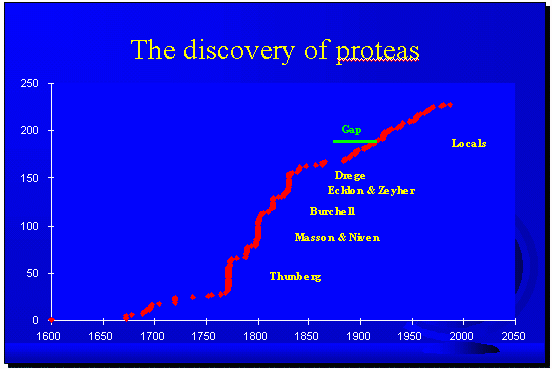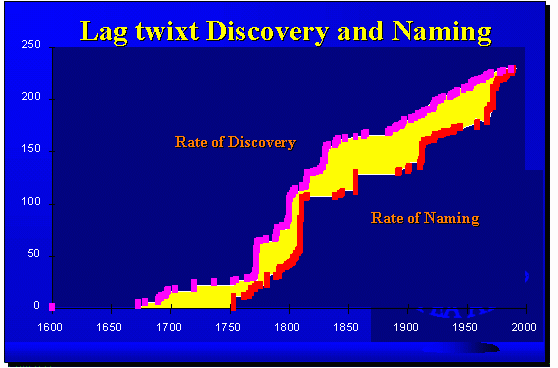
Home
Mission
Overview of Project
Project Staff
Sponsors
Achievements
Checking, Illustrations
Upcoming Activities
Id and Species Lists
Protea Information
Protea Gallery
Growing Proteas
Interim Dist. Maps
Publications
Afrikaanse Inligting
![]()
Important Events in the Discovery of Proteas
Beginnings
1605: Carolus Clusius (1526-1609 - Dutch Botanist): Exoticum
Libri Decem - Fructus XV - Protea neriifolia (first
southern African plant recorded)
1672: Paul Hermann (1646-1695 - Prof Botany & Medicine, Leiden) visited the Cape to collect plants - published list of species in his herbarium in 1737 (by Johannes Burman (1707-1779)
1682-1687: Hendrik Claudius (1655-1697 - apothecary) sent to Cape to draw plants - assembled by Nicolaas Witsen (1641-1717): Codex Witsenii
1693: Mr Goddard presented Protea repens & Silver Tree to Royal Society in London description and engraving in Philosophical Transactions as Conifera Alypi folio
1705: Leonard Plukenet (1642-1706 - Physician & Superintendent: Hampton Court Garden) published Amaltheum Botanicum with: Thymelaea capitata Rapunculoides & Scolymodendros Africanus ex Monte Tabulari
1720: Herman Boerhaave (1668-1739 - Prof Botany, Chemistry
& Physics) Index Alter Plantarum published from plates
by H.B. Oldenland 24 proteas, including:
Lepidocarpodendron folio saligna lato caule
purpurascente
Conocarpodendron folius argenteus sericeus
latissimus
Hypophyllocarpodendron folius inferioribus apice
trigido rubro imperrioribus penitus rubris glabris

Taxonomical revolution
1735: Carl Linnaeus (1707-1778) Systema Naturae
The binomial systemtypes and descriptions.
(genus + species): The genus Protea based on the
Silver Tree
1737: Hortus Cliffortianus: Protea in Clifford's
garden at Hartecamp
1753: Species plantarum. Protea, Leucadendron,
Brabejum BASELINE FOR PLANTS
1771: Mantissa: everything under Protea
1751: Johan Auge (1711-1805) became superintendent of the
Dutch East India Company's garden at Cape Town and collected
plants. Later accompanied Thunberg & Masson
1772-1775: Carl Thunberg (1743-1828) visited the Cape
purpose: to collect herbarium specimens for future study in
Sweden
1781: Dissertatio Botanica de Protea = "Father of
Cape Botany"

Age of Cultivation
1772-1774 & 1786-1795: Francis Masson (1741-1805) visited the Cape purpose: to collect seeds and living specimens for cultivation at Kew
1789: Willaim Aiton (1731-1793 - Gardener to his Majesty at Kew) published Hortus Kewensis - Proteas grown at Kew from Masson's seeds: Protea repens first
ca1800: Lee & Kennedy's nursary - the Vineyard (Hammersmith, London)
1798-1803: James Niven (1774-1827) visited the Cape to collect seeds with voucher specimens for Joseph Knight, gardener to George Hibbert (1757-1837 - merchant with East & West India Company).
1803-1812: Cape visit to collect seeds for Lee & Kennedy & Empress Josephine.
The Great Dispute
1801: Robert Brown (1773-1858) visits Cape as Naturalist on HMS Investigator on way to Australia & New Zealand
1805-8: Richard Salisbury (born Markham, 1761-1829) writes text for Paradisus Londinensis. (First grew proteas in 1796)
1807: in Paradisus Londonensis: a new generic classification for the Proteaceae
17 January 1809: Robert Brown reads "On the Proteaceae of Jussieu" to Linnaen Soc. of London. Richard Salisbury in audience.
1809: Joseph Knight publishes On the cultivation of the plants belonging to the Natural Order of Proteeae with text by Richard Salisbury.
March 1810: Robert Brown's On the Proteaceae of Jussieu published
Age of Exploration
1811-1815: William Burchell (1781-1863) visits the Cape to collect plants
1800: Johan Wendland (Inspector Royal Honoverian Gardens) publishes Hortus Herrenhusanus of plants in the Royal Gardens at Hannover
1822-58: Carl Zeyher (1799-1858) came to the Cape to collect plants
1823-68: Christian Ecklon (1795-1868) came to the Cape to collect plants
1826-34: Johann Drege (1794-1881) visits the Cape to collect plants
1841: Klotzsch & Otto publish Icones plantarum rariorum horti regii botanici Berlinensis dealing with plants at Berlin Royal Botanic Garden
Age of Evaluation
1847: Stephen Endlicher (1804-1849 - Austria) revised proteas in Mantissa Botanica
1856: Carl Meisner (1800-1874 Prof. Botany Basle) revised proteas in Vol 14 of De Candolle's Prodromus
1891: Otto Kuntze (1843-1907) revised proteas in Revisio Genera Plantarum
1891-1898: Rudolf Schlechter (1872-1925) visits the Cape to collect plants
1912: Edwin Phillips (1884-1967)& Hutchinson revised proteas in Flora capensis
Post-Colonial Era
Collectors:
Alfred Bodkin (1847-1930, Mathematician) collected in the higher mountains
Rudolf Marloth (1855-1931, Naturalist)
John Muir (1874-1947, GP) collected Riversdale area
Thomas Stokoe (1868-1959, Lithographer) collected mainly in the Caledon area
Elsie Esterhuysen (1912-, Botanist) collected extensively all over
Taxonomists:
John Beard () 1969: Tropical Protea
John Rourke (): Leucospermum (1972), Protea (1982), Sorocephalus & Spatalla (1969)
Margerette Levyns () 1970: Paranomus
Ion Williams () 1972: Leucadendron
Age of Extinction and Understanding
Marie Vogts, William Bond, Protea Atlas Project
Back Proteas in History